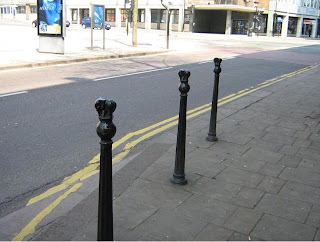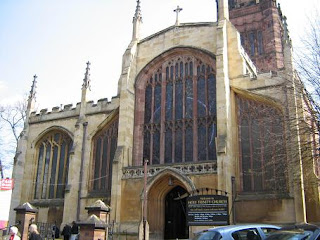The next day (Sunday) my cold was flourishing, and I wasn't up to much site seeing. My kind hosts took me on a slow paced tour of Coventry.
The seal of Coventry includes an elephant, and hence there are elephants all over the place! Here are some little elephants on top of some decorative bollards:
A story that Coventry is famous for is the story of Lady Godiva, who rode naked through the streets of Coventry to persuade her husband to reduce the onerous taxes on the city. Naturally, there is a statue of her in Coventry:
During World War 2, Coventry, which was a major manufacturing centre, was hit very hard by the Blitz. The city was very nearly levelled. Only a few remaining buildings date to before World War 2.
One of the remaining buildings is the 12th Century Holy Trinity Church. Because it was a Sunday, and service was just finishing as we walked past, we were able to go in and have a look.
Above the archway in this photo you can just make out the lower part of the 15th Century "Doom" painting, which has recently been restored. Unfortunately, this was the best photo I got of it!
There were also some very lovely stained glass windows.
A significant architectural casualty of WW2 was the Coventry Cathedral. The walls were left standing, but the roof and interior were destroyed. A new cathedral has been built facing the original cathedral, and the two buildings make a striking contrast. The first photo is of the new cathedral, with very modern architecture.
In the second photo you can see the columns at the front of the new cathedral, and behind them the archways of the old cathedral.
Finally, the main entry windows of the new cathedral, seen through the original doorway of the old cathedral.
The old cathedral, in contrast, looks like this:
The scorch marks on the walls from the incendiaries are still very clear.
There are still some small sections of stained glass that survived the fire. The edges are melted from the heat, but the stonework is intact.
The visit to the cathedrals was fascinating and sobering at the same time.
Afterwards, we went to a small museum near by, with displays about Coventry's history. There were examples of machines that were used for watchmaking and ribbon making. The automated ribbon making machines used a kind of metal punch card to control the pattern that was woven into the ribbons. Really interesting stuff.
That evening my hosts headed off to a concert. I had been planning to join them, but the cold defeated me, so I got an early night.
























































